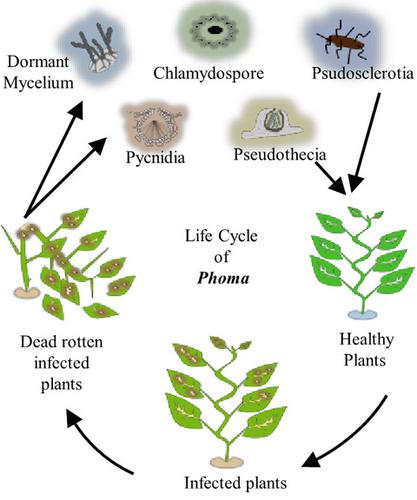当前位置:
X-MOL 学术
›
Plant Pathol.
›
论文详情
Our official English website, www.x-mol.net, welcomes your
feedback! (Note: you will need to create a separate account there.)
Phoma diseases: Epidemiology and Control
Plant Pathology ( IF 2.3 ) Pub Date : 2020-06-17 , DOI: 10.1111/ppa.13221 Debasish Deb 1, 2 , Ahamed Khan 2, 3 , Nrisingha Dey 2
Plant Pathology ( IF 2.3 ) Pub Date : 2020-06-17 , DOI: 10.1111/ppa.13221 Debasish Deb 1, 2 , Ahamed Khan 2, 3 , Nrisingha Dey 2
Affiliation

|
Phoma is the most widely distributed and omnipresent genus of the order Pleosporales and the largest genus with some 3,000 taxa described so far. Of these, approximately 110 species are pathogenic and occupy varied ecological niches. The genus Phoma is polyphyletic and is not really delimited, with unclear species boundaries that make it a taxonomically controversial genus. Fungi belonging to Phoma commonly occur on crop plants that are economically important, where they cause devastating plant diseases. Pathogenic members of Phoma sensu lato species attack crop plants with symptoms ranging from leaf blight to root rot, and even wilting of the plant. In infected crop residues and field stubbles, the pathogen produces abundant pycnidia and pseudothecia that serve as the source of primary inoculum, whilst repeated crops of conidia produced inside pycnidia are the main source of secondary infection during the same growing season. After successful infection, the pathogen produces various phytotoxins that alter photosynthetic efficiency and actin cytoskeleton‐based functions, and cause electrolyte leakage from cells. Controlling the diseases caused by members of Phoma sensu lato is challenging and efforts have been made to identify resistant varieties that can be used in various plant breeding programmes. Studies have also been conducted to devise cultural and biological control measures as well as to evaluate the efficacy of fungicides against members of Phoma sensu lato. In this review we aim to discuss the disease epidemiology and control measures that can be practised to protect crops from Phoma diseases.
中文翻译:

Phoma 疾病:流行病学和控制
Phoma 是 Pleosporales 中分布最广、无所不在的属,也是迄今为止描述的最大的属,约有 3,000 个分类群。其中,大约 110 种是致病的,占据不同的生态位。Phoma属是多系的,并没有真正划定界线,物种边界不明确,使其成为一个在分类学上有争议的属。属于 Phoma 的真菌通常发生在具有重要经济意义的作物上,在那里它们会导致毁灭性的植物病害。Phoma sensu lato 物种的致病成员攻击农作物,症状范围从叶枯病到根腐病,甚至植物枯萎。在受感染的作物残茬和田间残茬中,病原体产生丰富的分生孢子和假膜,作为主要接种物的来源,而在同一个生长季节,分生孢子内部产生的分生孢子重复作物是继发感染的主要来源。成功感染后,病原体会产生各种植物毒素,改变光合作用效率和基于肌动蛋白细胞骨架的功能,并导致细胞电解质泄漏。控制由 Phoma sensu lato 成员引起的疾病具有挑战性,并且已经努力识别可用于各种植物育种计划的抗性品种。还进行了研究以设计培养和生物控制措施以及评估杀菌剂对 Phoma sensu lato 成员的功效。在这篇综述中,我们旨在讨论可用于保护作物免受 Phoma 病害的疾病流行病学和控制措施。
更新日期:2020-06-17
中文翻译:

Phoma 疾病:流行病学和控制
Phoma 是 Pleosporales 中分布最广、无所不在的属,也是迄今为止描述的最大的属,约有 3,000 个分类群。其中,大约 110 种是致病的,占据不同的生态位。Phoma属是多系的,并没有真正划定界线,物种边界不明确,使其成为一个在分类学上有争议的属。属于 Phoma 的真菌通常发生在具有重要经济意义的作物上,在那里它们会导致毁灭性的植物病害。Phoma sensu lato 物种的致病成员攻击农作物,症状范围从叶枯病到根腐病,甚至植物枯萎。在受感染的作物残茬和田间残茬中,病原体产生丰富的分生孢子和假膜,作为主要接种物的来源,而在同一个生长季节,分生孢子内部产生的分生孢子重复作物是继发感染的主要来源。成功感染后,病原体会产生各种植物毒素,改变光合作用效率和基于肌动蛋白细胞骨架的功能,并导致细胞电解质泄漏。控制由 Phoma sensu lato 成员引起的疾病具有挑战性,并且已经努力识别可用于各种植物育种计划的抗性品种。还进行了研究以设计培养和生物控制措施以及评估杀菌剂对 Phoma sensu lato 成员的功效。在这篇综述中,我们旨在讨论可用于保护作物免受 Phoma 病害的疾病流行病学和控制措施。











































 京公网安备 11010802027423号
京公网安备 11010802027423号